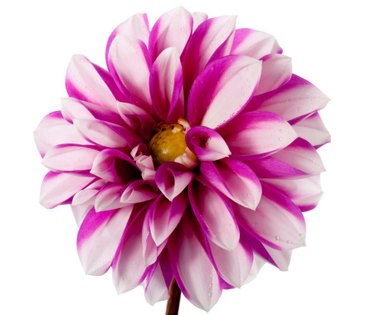
Flowers cannot speak, but they do manage to convey their own meanings. As metaphors, flowers can voice complex human emotion with a grammar drawn from longstanding traditions. As gifts, flowers have long conveyed gratitude, not simply love and affection, including the typically amorous roses — as long as they are dark pink. With flowers, color and shape provide their syntax and phrasing.
Dahlia
Video of the Day
With feathered petals that can be red, orange, pink, purple, white or yellow unfolding atop strong stems that can extend 4 feet to 6 feet among its larger cultivars, dahlias have a long history. Long before colonization and horticulturalists devised more than 20,000 garden cultivars, dahlias were grown for beauty and utility by the Aztecs. They used dahlias for animal feed and medicinal treatments. Their sustenance and healing possibilities ascribed gratitude to the dahlia's then elegant simplicity: eight scarlet petals circling a yellow disc. Now that gratitude can be amplified with a cultivar that gardeners call the "dinner plate dahlia" because its blooms spread 8 inches to 12 inches in diameter.
Video of the Day
Bluebell
Branched open clusters of fragrant tubular blooms nodding with the wind give the bluebell, or Hyacinthoides non-scripta, its common name, even though its flowers need not be blue. They can be pink, violet-blue or white. Bluebell flowers have long symbolized gratitude, humility and constancy. In the United Kingdom, where the perennial woodland flower is native, that gratitude comes with a mythical sense of magic associated with faeries. Wild bluebells cannot be picked there because they are protected by the Wildlife and Countryside Act. The bluebell flowers that florists sell are hybrids and can vary in detail from the wild bluebells, which have stems that can extend between 4 inches and 11 inches and droop near the end to allow all the blooms to point downward on one side of the stem.
Camellia
In the Far East, the camellia's bright pink or red rose-like blooms that range from 5 inches to 8 inches in diameter have long symbolized gratitude and commitment. In Korea, camellia flowers have been a wedding mainstay for centuries. Now, more than 3,000 camellia cultivars are grown in the southeastern United States. As striking as the camellia flower's elegantly arranged petals circling its pistil are the plant's glossy broad leaves, which maintain a deep-green color year-round. Traditional or wild camellia flowers have five or six red petals. Most cultivars bear more and can range in color, including pink, red and white. Some cultivar petals can be multicolored.
- Utah State University Cooperative Extension: What Kind of Flowers Should I Send?
- School of the Season: Dallying with Dahlias
- Floridata: Dahlia
- USDA Natural Resources Conservation Service: Hyacinthoides Non-Scripta (L.) Chouard ex. Rothm. English bluebell
- Floridata: Camellia Japonica
- "Elsevier's Dictionary of Plant Lore"; Donald Watts; 2007
- The Wildlife and Countryside Act, 1981